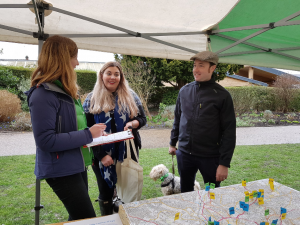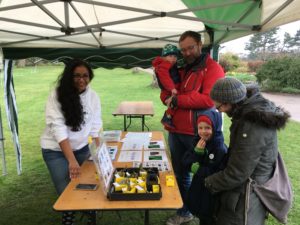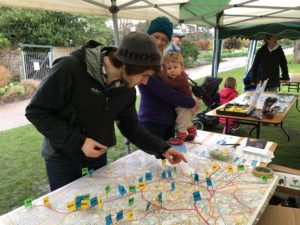
Sarah Knight, UK Data Service Data Impact Fellow and PhD student in the Environment Department of the University of York, talks about how she engaged with the public to discuss air pollution issues and to develop understanding of people’s experiences of air pollution.
This month I have been mostly…talking to the public! I have been lucky enough to be part of a public engagement programme since January 2017 to discuss air pollution issues.

Making the Invisible Visible
I was one of seven PhD students on the NERC-funded Making The Invisible Visible programme. The programme brought together students, researchers, and practitioners at the Universities of York, Leeds and Sheffield, the Stockholm Environment Institute (SEI) and The Conservation Volunteers to organise and conduct activities that would allow dialogue between us and other public groups. The aims of these activities were to engage people in air pollution issues, provide information and knowledge, and develop our own understanding of people’s experiences of air pollution.
My current research explores how exposure to air pollution, specifically nitrogen dioxide, impacts subjective well-being, so I was really interested in discussing this issue with members of the public. Who knows what fascinating topics we’d discuss!
As part of the programme I organised a public engagement event with colleagues at SEI and the University of Sheffield, as part of the Sheffield Festival of Science and Engineering. It was a one day event on Saturday 18th March 2017 in the Sheffield Botanical Gardens, and we named it AirFest.
What happened at AirFest?
Maria, Kadam and I ran a series of small interactive activities with passers-by, focussed on air pollution issues in Sheffield. These included a lichen identification stand, which demonstrated how lichens are great indicators of good/poor air quality! We also ran a Rapid Appraisal Participatory GIS (PGIS) activity, which involved getting people to engage with our big map of Sheffield! We wanted to know the locations that people associated with high levels of air pollution, what their concerns were relating to this, and how this affected their well-being. We also designed an online quiz that could be conducted on our tablets, and we had loads of giveaways and factsheets for people to take away.

Despite the rain, the event was fun and well-attended, and we had some fascinating conversations! We had a steady stream of people at the event which lasted 4 hours after Maria’s talk and walk to the air quality garden at Sheffield Botanical Gardens! Lots of families with children attended, who really enjoyed the lichen activity. We were able to conduct 19 surveys for the PGIS activity, and the online quiz was completed 31 times with scores ranging 14-100%. The press turned up! They interviewed Maria and then videoed us conducting the activities…although I’m not sure where that video ended up!
AirFest and impact
So how did this programme have impact? I think the activities that we ran provided new knowledge and awareness to those who attended, in terms of facts about pollution, and ways to reduce one’s own emissions and exposure. Children seemed fascinated by the lichens and the quiz, and I had many conversations with adults who seemed very surprised by some of the pollution facts. I was able to discuss my use of well-being and pollution data with several groups of people and we had some great exchanges about what data is available, what well-being means, how you measure it and how you connect it to data about the physical environment.

I myself developed new understanding about people’s concerns and behaviours regarding air pollution, and the possible pathways in which this may affect their self-reported well-being. For example, how several individuals said they would walk or cycle instead of driving, if only the traffic wasn’t so bad…! And more broadly being part of this programme taught me some very useful practical things about how we as researchers can work best with different publics at events like this. My thoughts:
- Plan for your audience – in terms of content, activity type, safety, facilities, everything!
- It is better to do one thing well than try to do too much – keep events simple
- It is possible to run web-based quizzes in the great outdoors on tablets!
- Waterproof everything. Trust me, just do it.
- People love a map – so many people are fascinated by their immediate environment and a map facilitates a conversation in such interesting ways.
- For the less experienced of you (like me, a PhD student) – start your career in public engagement by latching on to an existing event, for example a science fair. Much of the logistical planning is already covered (food, toilets, timings, location etc) so all you need to concentrate on is your activity.
- Base your evaluation on your aims – be clear about the impact you would like to have, and then plan your evaluation methods in line with them. And of course be ready to capture any unintended impactful happenings along the way!
What did I learn about impact?
Measuring impact can be difficult and sometimes feel intangible, but that there are many ways to do it! Qualitative statements are just as good as quantitative measures, and both together can be very powerful. Events like this are fast-paced and busy, and you speak to a lot of people in a short space of time. But they are fun! In an ideal world we would be able to collect longitudinal impact measurements, for example before- and after- event behaviour, but then the world of public engagement sometimes does not allow this!

Seemed like a great put together event! will there be anything similar in the near future? 🙂